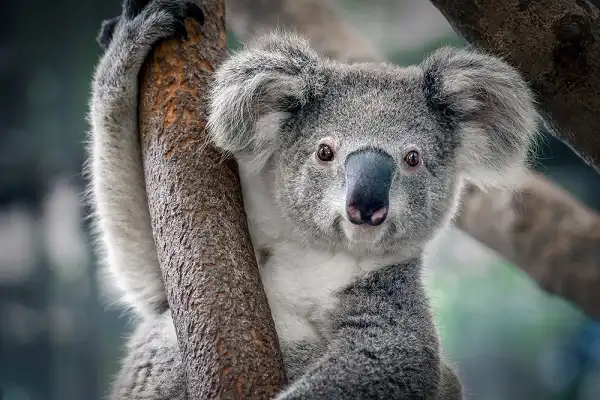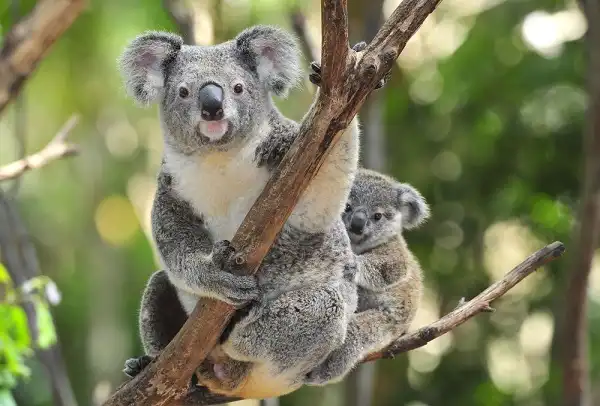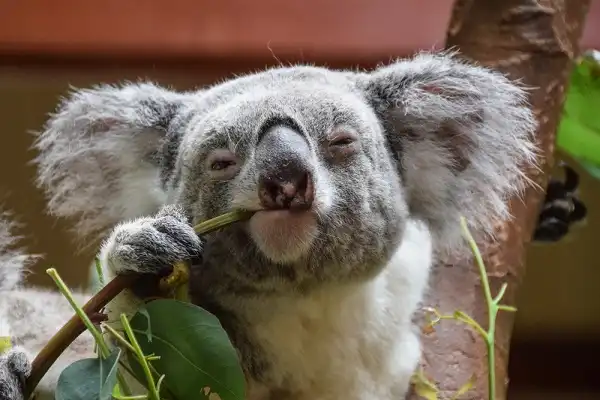Are you a fan of Australia’s wildlife? If so, then the koala is sure to be one of your favorite creatures! This cuddly marsupial has captivated audiences around the world with its sleepy demeanor and big eyes. But what makes these adorably fuzzy animals truly remarkable is their unique abilities that are often overlooked. From incredible climbing skills to an interesting diet, there is much more than meets the eye when it comes to these Australian icons. Read on to learn all about this special species and why they’re worth protecting!

Koala Description
Koalas are small marsupials that can be found living in the forests and coastal regions of eastern Australia. These cuddly animals have a distinctive stout, tailless body that is covered in thick fur. The fur ranges from pale grey to brown and is often white on the underside and around the muzzle. They have short, rounded ears and a nose shaped like a spoon. Koalas also have five digits on each paw which help them climb trees with ease. Their eyes are large and black, with a white circle around the pupil, giving them their iconic “panda eyes” look.
Koala Habitat
Koalas are found living in the forests and coastal regions of eastern Australia, primarily in Queensland, New South Wales, Victoria, and South Australia. They inhabit a variety of habitats including eucalyptus woodlands, brush forests, low-lying wetlands, and mangrove swamps. They are mostly found in areas with an abundance of eucalyptus trees as these trees provide them with food and shelter. Koalas prefer to live in tree hollows or caves on steep slopes or rocky outcrops. Not only do these areas contain food sources such as leaves and buds, but they also provide protection from predators. Koalas have adapted to living in a wide range of climates from arid deserts to humid rainforests. However, they typically prefer cool temperatures and moist conditions as this helps keep their bodies hydrated. They can be found living at altitudes ranging from 0-1300 meters above sea level but tend to stay closer to sea level where temperatures are cooler and there is more vegetation available for sustenance.
Koala Diet
Koalas are completely reliant on eucalyptus leaves for sustenance, and they can consume up to 500 varieties of them! They require a high amount of energy and nutrition from the leaves due to their slow metabolism. This means that koalas rely on toxins within the eucalyptus leaves to keep their digestive system healthy. These toxins also act as a natural insect repellent, keeping koalas safe from predators. Not only do koalas consume eucalyptus leaves but they also eat nectar, pollen, and bark occasionally. During the summer months when food is more abundant, they may even supplement their diet with fruit and flowers! Koalas have an interesting eating habit where they hold onto the branch while eating, which allows them to remain still until the food is finished.

Koala Size
Koalas are typically around 60 to 85 cm (2–3 ft) long, with adult males usually measuring at slightly larger sizes than females. The size of koalas varies according to their geographical location as well as age and gender. In southern Australia, koalas tend to be much smaller than those found in northern areas – this is likely due to differences in climate and diet. Baby koalas are also much smaller than adults; newborns measure just 2 centimeters at birth! Furthermore, male koalas can weigh up to 14 kg while females only reach 8kg on average.
Koala Lifespan
Koalas typically have a lifespan of around 13-18 years in the wild. In captivity, they can live up to 20 years. Females tend to live longer than males due to their ability to produce more young and more frequently. The longevity of koalas is largely affected by climate and available food sources as well as the level of predation they experience. Low predation rates, access to suitable habitats with plenty of vegetation, and an abundance of food all contribute to longer lifespans. The oldest koala on record lived to be 22 years old at a wildlife reserve in Queensland, Australia. However, this is quite rare and most koalas usually die much sooner due to injury or illness caused by human activity such as car accidents or dog attacks. Regular fires often destroy large areas of habitat which also lead to koala deaths.
Koala Behavior
Koalas are incredibly social creatures, and they have a complex system of communication that can involve vocalization, scent marking, grooming, and physical postures. For example, younger koalas will use their vocalizations to signal to an adult when they are in need of help or protection. In addition, adult koalas will use physical postures such as reaching out or making themselves look bigger to indicate that they would like to be left alone. During the day, koalas spend most of their time sleeping in trees while still being able to keep a lookout for predators. They usually become active in the early evening hours and will continue moving around until the sun rises again. This is also the time when they feed on eucalyptus leaves which helps them remain hydrated throughout the night.

Koala Speed
Koalas are not the fastest creatures in the animal kingdom, but they have evolved to be adept climbers and can move through trees with ease. On average, they can travel up to 13 km/h (8 mph) when running on flat ground, but their speed is much slower when climbing trees due to the need for a secure grip. They usually take short strides of around 1-2 meters (3-6 feet) at a time while climbing and can reach heights of up to 18 meters (60 feet). When threatened, koalas will climb higher into the safety of the treetops or abandon their current tree completely in search of another refuge. If escaping by ground, they will run quickly in short bursts and use obstacles like stones or logs to hide behind. While running may not be their primary defense strategy, koalas have been observed hopping over distances of 3-4 meters (10-13 feet) – this is an impressive feat considering their size! Koalas also have remarkable swimming abilities despite their bulky form which allows them to navigate waterways quickly if necessary. In fact, they are capable of sustaining speeds of up to 4 km/h (2.5 mph) while swimming which is quite rapid given how slow they typically move on land!
Koala Reproduction
Koala reproduction begins when a male koala attracts a female with his bellowing calls during mating season. The female will then choose her mate based on size, health, and the available food sources in his territory. After courtship is established between both partners, they will stay together for around 24 hours before parting ways until the next mating season. Once pregnant, a female koala can give birth to 1 or 2 babies – called joeys – after an average gestation period of 35 days. At this stage, the joeys are just tiny hairless creatures that need to make their way to their mother’s pouch where they will remain for the first five months of their lives before emerging fully developed. At 6 months old, the joey is weaned and spends more time outside of its mother’s pouch while learning how to climb and feed itself. It is not until about 18 months old that the joey is ready to leave its mother completely and establish its own territory as an adult.
Koala Predators
Koalas face a number of predators in the wild, including birds of prey such as hawks and eagles, as well as wild dogs, cats, dingoes, and even humans. Although koalas have many adaptive behaviors that help them to survive in the face of danger, these predators can still pose a significant threat to their survival. Birds of prey are among the most common predators for koalas. These large birds have sharp talons and beaks that can easily kill young or vulnerable koalas. They may also target adult koalas if they come across one asleep on the tree tops or on the ground. To defend themselves from these flying predators, koalas will often climb higher into the safety of treetops or seek shelter in dense foliage.

Koala Hunting
Koala hunting is an activity that has been practiced in Australia for hundreds of years, and while its prevalence has diminished due to conservation efforts, it still takes place today. Koalas have long been hunted as a source of food by indigenous Australian communities and were also targeted by commercial hunters during the 19th century. Much of this hunting occurred in response to the increasing number of koalas that were being killed in the wool industry. Today, koala hunting is generally not allowed in most parts of Australia and laws have been enacted to protect these animals from hunters. However, there are some exceptions that allow licensed hunters to hunt koalas for research or educational purposes. In addition, there are certain Indigenous communities who are allowed to hunt koalas for their own dietary needs under special permits issued by the government. In general, most hunting methods used on koalas involve either guns or traps – both of which can be extremely cruel and dangerous for these animals if not managed properly. For this reason, it is important that any hunting activities are done responsibly and with respect for the animal’s welfare in mind.
Conclusion
Koalas are an iconic species of Australian wildlife that play a vital role in the country’s ecosystems. Despite their cuddly appearances, koalas face many threats in the wild – from predators such as birds of prey or wild dogs to humans through hunting and habitat destruction. Fortunately, recent conservation efforts have helped increase public awareness about these animals which has improved their chances of survival significantly over recent years. Through regulating hunting activities and protecting habitats, we can ensure koala populations remain healthy into the future so that they can continue to bring joy to all who come across them!
Frequently Asked Question


